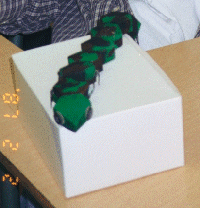I've got that Geometry Bug!
A
day in the life of my Geometry Bug
 It is early fall and the hexagonnar
is roaming about on the floor of a deciduous forest in Northern America. He is
careful to be on the lookout for predators, sniffing the air and looking back
and forth, while he searches for acorns and other nuts to store for the winter.
He suddenly spots a fox sneaking through the brush and takes off. Its eight
legs located in the front of its body pull the rest of the smooth agile body
through the leaf covered ground. The very sensitive tips of the legs feel for
soft ground. In the blink of an eye, the Hexagonnar is no longer running from its
hungry predator, but digging a small tunnel into the ground. Much like an
earthworm, the Hexagonnar eats the dirt and passes it through its system to
make room for more dirt. Unlike the earthworm, though, the Hexagonnar is doing
it at a very rapid pace. Its tiny legs propel it through the ground at an ever
increasing angle as its pointed face and large mouth clear the dirt. The fox,
even though it was close isn’t fast enough to catch the Hexagonnar as it has
already disappeared underground after only two and a half second of digging!
The Hexagonnar curls up into a tight ball and goes to sleep.
It is early fall and the hexagonnar
is roaming about on the floor of a deciduous forest in Northern America. He is
careful to be on the lookout for predators, sniffing the air and looking back
and forth, while he searches for acorns and other nuts to store for the winter.
He suddenly spots a fox sneaking through the brush and takes off. Its eight
legs located in the front of its body pull the rest of the smooth agile body
through the leaf covered ground. The very sensitive tips of the legs feel for
soft ground. In the blink of an eye, the Hexagonnar is no longer running from its
hungry predator, but digging a small tunnel into the ground. Much like an
earthworm, the Hexagonnar eats the dirt and passes it through its system to
make room for more dirt. Unlike the earthworm, though, the Hexagonnar is doing
it at a very rapid pace. Its tiny legs propel it through the ground at an ever
increasing angle as its pointed face and large mouth clear the dirt. The fox,
even though it was close isn’t fast enough to catch the Hexagonnar as it has
already disappeared underground after only two and a half second of digging!
The Hexagonnar curls up into a tight ball and goes to sleep.
 This is the exciting part of the day
of a Hexagonnar. After a short nap, the hexagonnar is ready to eat. He quickly
"eats" his way to the surface and slowly pops his head out the top of
the hole. He spins around 360 degrees until he is sure the coast is clear. His
small green head wouldn’t even be noticed by most predators. The hexagonnar
crawls out of its hole and follows his nose to green leafy plants. His eyesight
is not very good because his eyes are so far apart. They are mostly used to
sense motion. After finding a plant, he eats quite a large serving for someone
his size. After the large meal, he walks around in search of nuts to store for
winter.
This is the exciting part of the day
of a Hexagonnar. After a short nap, the hexagonnar is ready to eat. He quickly
"eats" his way to the surface and slowly pops his head out the top of
the hole. He spins around 360 degrees until he is sure the coast is clear. His
small green head wouldn’t even be noticed by most predators. The hexagonnar
crawls out of its hole and follows his nose to green leafy plants. His eyesight
is not very good because his eyes are so far apart. They are mostly used to
sense motion. After finding a plant, he eats quite a large serving for someone
his size. After the large meal, he walks around in search of nuts to store for
winter.
He is able to maneuver
around almost anything even though he is not small. This is because of the
properties of hexagons. They can fit tightly together. The hexagonnar can roll
up into a ball and conserve heat energy because of this. His spine is an
elastic cylinder that allows him to stretch and bend and still stay together.
It move by crawling with its eight legs and by using muscles to swing and move
the rest of the body around. To dig, all it does is open its jaw while it is
running and lower its head. It starts at a small angle, just scooping up a
little dirt, but it keeps lowering its head until it is going straight down.
The bug is colored like army camouflage and is very difficult to be seen,
especially by its biggest predator, the hawk. Also, its ability to completely
change directions with ease makes it difficult to swoop down on. One of the
most helpful parts of the hexagonnars body is the tail in the back, which emits
an electrical shock on command. This is useful for when it is burrowing because
if it can’t get completely underground, and is caught by a fox or other animal,
the tail protects the last few sections because if touched there, it can reach
it and shock it. That is used as a final defense.
The head comes to a peak in
the front which is good to push excess dirt to the side while burrowing. It
also forms a sort of beak that allows the hexagonnar to crush nuts and eat
them. The head also includes many different quadrilaterals. The legs are made
of bent cylinders.
The hexagonnar is an agile,
centipede-like, herbivore that lives in North American deciduous forests. It
hibernates in the winter and is awake most of the other seasons, taking a few
naps as needed and 6 hours every night. It moves fairly quickly and can dig
just as fast. It doesn’t have a lot of predators because its geometrical design
makes it very hard to catch.
Project
Description
Research Questions
Student Work
|